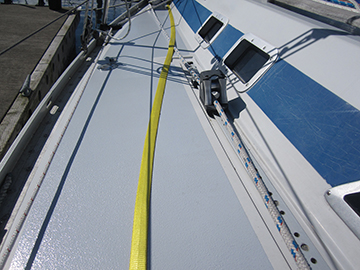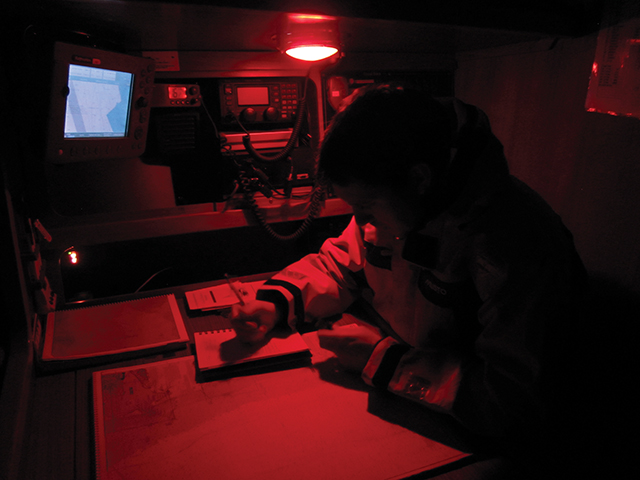Crew tips for completing safe passages at night (published May 2013)
Someone once asked me if I stopped to sleep every night when making an offshore passage. Initially, it is a funny question, but when you get down to it, they are actually focusing on a key component: sleep. Offshore sailors need sleep just like anyone else and a properly functioning night watch schedule is designed to accomplish that goal. The fact of the matter is, when sailing offshore at night, nothing is more vital to the success of the voyage than a well-rested crew.
The reality of sailing on the ocean at night is that it is an absolutely amazing experience, parallel to few other things in life. But with that reward comes a certain amount of risk and mitigating that risk is not just up to the person in charge but every crewmember onboard. As has been said many times over, safety aboard is predominantly a function of how well prepared you are, so make sure you have the requisite amount of knowledge and experience to go with a well founded boat. When preparing my crew and vessel for an overnight passage, I break safety into several categories: vessel preparation, pre-sunset, on watch and off watch.
PREPARING YOUR VESSEL
An experienced crew is one thing, but they are nothing without a vessel that is as prepared as they are. Setting up a sailboat to go offshore at night is not difficult since most of what you use after sunset is pertinent to daytime passagemaking as well. When sailing coastally, AIS and radar are valuable pieces of equipment to have for both ship avoidance and piece of mind. Make sure each crewmember knows how to operate them and if you are sailing in the open ocean with very little shipping traffic, turn them on only every half hour or so to conserve battery power.
Jacklines are essential for safe crew movement to and from the foredeck. Never attach a tether to a lifeline and if you lay your jacklines on deck, make sure they are made of flat webbing, since round lines tend to roll under foot. When sliding your tether up and down a jackline, try not to let your tether’s clip drag on deck; the sound can awaken the off watch crew below decks. Whether your jacklines lie on deck or are rigged chest high, practice moving forward before sunset or leaving the dock. This will help you work out the best way to set them up and will commit your path forward to memory. Also, tape or Velcro pelican hooks closed so they will not inadvertently open while at sea.
All your control lines, reef lines, halyards, sheets and winch handles need to be easily accessible and neatly stowed. Rig a preventer on the boom and check the working order of your spinnaker or whisker pole if you plan to use one. If you have crew who are unfamiliar with the lines on your boat, give them a thorough tour before shoving off. Labels eliminate any guesswork. I once asked a crewmember to ease the main sheet at night and he inadvertently opened the clutch for the main halyard.
Although you should never assume another vessel sees you on the ocean, having properly colored and working running lights are an absolute necessity that can prevent a catastrophe. Check your running lights before heading offshore and make sure to carry spares for each one. Also, brush up on your ability to understand the lights on other vessels and always have a good set of binoculars and a book or chart of ship’s lights at the ready to help with quick identification.
Getting your vessel offshore ready is just as important below deck as it is above. If you were to take a picture of the inside of a boat before a passage and after, many would look drastically different as things that seem to be stowed well at a dock aren’t at sea. That being the case, carefully stow all gear. Set up lee cloths, have a designated place for off watch crewmembers to hang wet foul weather gear and ensure seacocks that need to be closed are closed. Don’t forget to organize your navigation station and test all your communication equipment before leaving near coastal waters.
PRE-SUNSET
As enchanting as sailing at night can be, there are numerous things to think about and prepare for before the sun hits the horizon. Atop my pre-sunset checklist is to have a meeting with the crew. Even if it is just one other person, your crewmembers are valuable so treat them as such.
An hour or two before sunset, assemble your crew to put a finger on the pulse and see how everyone is doing. How have the last 24 hours been and what are the feelings about moving forward for the next 24? I don’t keep a stringent watch schedule during the day so I’ll ask how the previous night’s watch worked for everyone. Are you sleeping, eating and staying hydrated? Are there any concerns, comments or questions?
Next, move into a crew briefing so everyone knows the plan, procedures and processes before darkness falls. This briefing tends to be longer before the first night of a multi-day passage, but it is important that everyone knows what the plan is and what the expectations are.
Whether it is two hours on, or three or four make sure everyone knows and understands the watch schedule and when they are expected on deck. Relay navigation information such as what course and course changes are to be made and any points of navigational significance that will arise.
Weather is important both day and night so ensure the weather forecast for the next six to 12 hours is disseminated properly so sail or course changes can be made efficiently. Plan meals and drinks that are suitable to the crew and weather. Make sure the on watch crew knows what to look for and check while on deck, and what to do if something is amiss. Also, if you expect to sail through the night, top up your batteries before sunset so you won’t have to start the engine and wake those sleeping down below.
ON WATCH
 The on watch crewmembers are responsible for keeping the vessel moving well and safely on course. Therefore, do not get lost in a book or doze off, keep your head on a swivel and enjoy steering the boat while taking in the sights and sounds of the night. If you have been doing your job off watch—sleeping—you should have little trouble staying on task.
The on watch crewmembers are responsible for keeping the vessel moving well and safely on course. Therefore, do not get lost in a book or doze off, keep your head on a swivel and enjoy steering the boat while taking in the sights and sounds of the night. If you have been doing your job off watch—sleeping—you should have little trouble staying on task.
Starting with personal safety and responsibility, always wear a PFD, harness or both and clip in. Show up early for your watch and be prepared. Know the on watch procedures if you see lights on the horizon, if there is a large wind increase or shift, if you need to make a drastic sail change or if anything seems out of the ordinary. If something isn’t right, don’t be a hero, wake up the person in charge. And if you need to go forward and are the only person on deck, wake someone up; you should never go forward without someone watching you.
Scan the horizon every 10 to 20 minutes, check the radar and AIS, make proper log entries, keep an eye on the engine instruments if it is on and if it is not, check the house battery level at regular intervals. If the boat is equipped with red cabin lights, make sure you use them when down below so your night vision is not impaired when returning on deck.
When it is time for a watch change, don’t rush to your bunk without greeting or talking to those coming on watch. Brief the new watch standers on anything they may need to know. Also, be positive. It doesn’t help the crewmembers coming on watch to complain about how tired you are or how nasty the weather is—they’ll figure it out.
OFF WATCH
Your main duty when not on watch at night is to sleep. Because that is your focus, make sure your bunk is as comfortable and as dry as possible. If your bunk is fitted with a lee cloth, use it. And if you are a light sleeper, try bringing ear plugs to help block unwanted noise.
If you are on a multi-day passage it is not uncommon to find it hard to sleep during the first night. Eventually your body will adjust and sleep will come more easily each time you go off watch. By the third day, you will have adjusted to the new sleep pattern completely.
Lastly, set an alarm to wake you up 15 minutes before your shift is supposed to start. Get some food and something to drink, put on your foul weather gear and be prepared to get instructions from those who are coming off watch.
With sound seamanship and a well-prepared boat, making a passage at night should be a highlight of any sailor’s resume. If you have never sailed at night before, try it on a calm night with a full moon in your home waters. Get comfortable with what you see and how your boat is different with the lights out. Another good option is to find a sailing class or delivery opportunity with experienced sailors who will help make your learning curve less dramatic. No matter how you go at the experience, sleep well and enjoy the stars.

















